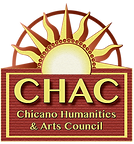

EDUCATION

FEATURED WORKSHOPS
FALL & WINTER 2023
All workshops listed below can be done at CHAC Gallery or at your location.
*Fees apply
Please include:
-
Name, email and phone number of Contact Person
-
Name and address of School, Business or Organization
-
Number of participants
-
Age or grade of participants
-
Date requested for workshop
-
Location of workshop (CHAC or School,etc)
-
What workshop are you interested in
Please e-mail brenda@chacgallery or eventcoordinator@chacgallery.org for pricing, durations and to learn more about individual classes.
Ojos de Dios/Ojos Portals
• 1st-5th, 6th-adult
A God's Eye (in Spanish, Ojo de Dios) is a spiritual and votive object made by weaving a design out of yarn upon a wooden cross. Often several colors are used. They are commonly found in Mexican and Mexican American communities, among both Indigenous and Catholic peoples. The spiritual eye of the Ojos de Dios is thought by some believers to have the power to see and understand things unknown to the physical eye.
Our craft can be easy for young children as well as complex for older teens and adults.
Sugar Skulls/Calaveras
• Kinder - adult
A calavera is a representation of a human skull. The term is most often applied to edible or decorative skulls made from either sugar or clay which are used in the Mexican celebration of the Day of the Dead and the Roman Catholic holiday All Souls' Day. Calavera can also refer to any artistic representations of skulls, such as the lithographs of José Guadalupe Posada. The most widely known calaveras are created with cane sugar and are decorated with items such as colored foil, icing, beads, and feathers. Our craft is made with little sugar skulls made with puffy paint or colored icing. Embellishments include sequins, little jewels and sparkles.
Festival of Bones/La Catrina
• 2nd - 8th
"La Catrina” has become the referential image of Death in Mexico. It is common to see her embodied as part of the celebrations of Day of the Dead throughout the country; she has become a motive for the creation of handcrafts made from clay or other materials, her representations may vary, as well as the hat." – J.G. Posada
Learn about the Mexican Holiday Dia de los Muertos, how they think about skeletons and skulls, and learn about Catrina and why she is so popular during this Holiday. Our Craft is all about dressing our little skeletons with cloth, yarns, clay and other embellishments.
Frida Kahlo Inspired Symbolic Self-Portraits
• 2nd - Adult
Frida Kahlo was a self-taught painter, best known for her self-portraits. At eighteen years old, Kahlo was seriously injured in a bus accident. She had to recover in bed for more than a year. During this time, Frida began to pass the time by painting still life and self-portraits. Frida was Inspired by her country's popular culture. Her paintings are in a native folk art style and often had strong autobiographical elements, mixed with realism with fantasy. In addition to belonging to the post-revolutionary
Mexicayotl movement, which sought to define a Mexican identity, Frida Kahlo's paintings have been described as a Surrealism or Magical Realisim.
Papel Picado and Papel Flores
• Kinder - 5th
Papel Picado is a decorative Mexican art craft made by cutting elaborate designs into sheets of tissue paper. They can also be made by folding tissue paper and using small, sharp scissors. Common themes include birds, floral designs, and skeletons. Papel picados are commonly displayed for Fiestas and religious occasions.
Papel Flores were first predominantly used in churches or home alters. When votive candles began being used in churches, the flowers were barred because they posed a fire hazard. Eventually paper flowers became more secular and were made more elegant and colorful.
Our Papel Picados and Flores are made simply with tissue paper and scissors.
Jaguar Masks
• Kinder - 6th
Jaguars are important to many cultures in Mexico, representing valor, ferocity, and power. The significance of the jaguar in Mayan culture is noticeable in their art, literature, and architecture. In fact, hunting a jaguar was a rite of passage from childhood to adulthood for children. Stories tell of the jaguar as a shapeshifting being, accompanying Mayan priests or Shamans.
Jaguar masks originated with the Mayan people located in the Yucatan peninsula. In the beginnings of the Mayan civilization, the Mayans adopted basic principles for their religion from the Olmec population and from Teotihuacan. The Mayans have always treasured their tribal mask; the one we will be making is the jaguar mask, which had many elaborate designs carved in, each carving having its own significance.
Catrina Masks
• 1st - 12th
"La Catrina” has become the referential image of Death in Mexico. It is common to see her embodied as part of the celebrations of Day of the Dead throughout the country; she has become a motive for the creation of handcrafts made from clay or other materials, her representations may vary, as well as the hat." – J.G. Posada
Learn about the Mexican Holiday Dia de Los Muertos and create your own Catrina mask to wear for Dia de Los Muertos.

Other Available Workshops:
-
Retablos 2nd-Adults
-
Mayan Weaving 2nd-Adult
-
Alebrijes 2nd-Adult
-
Water Color Corazon Kindergarten-3rd
-
Southwestern Wall Pockets 4th-Adult
%20(1).png)
